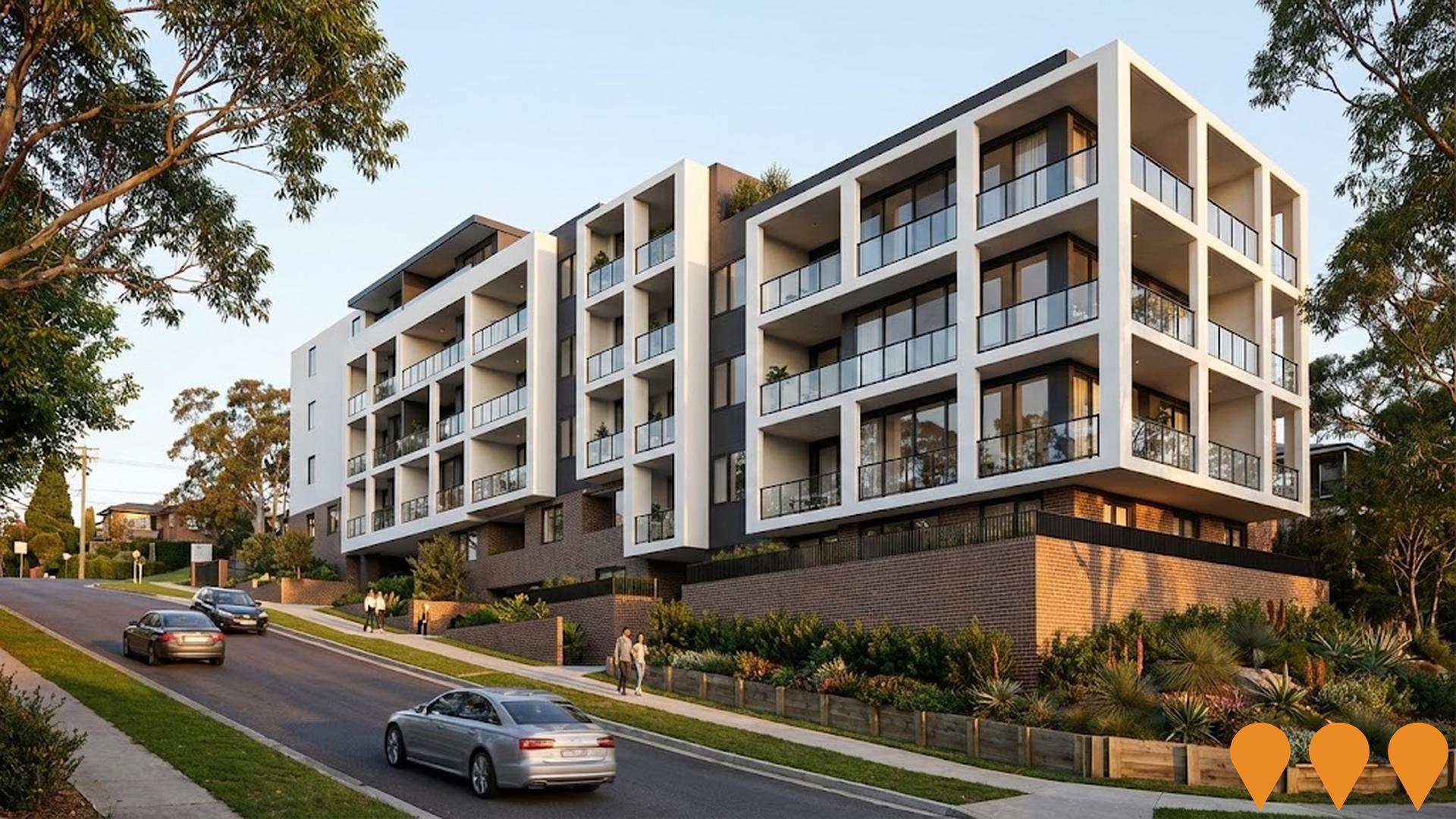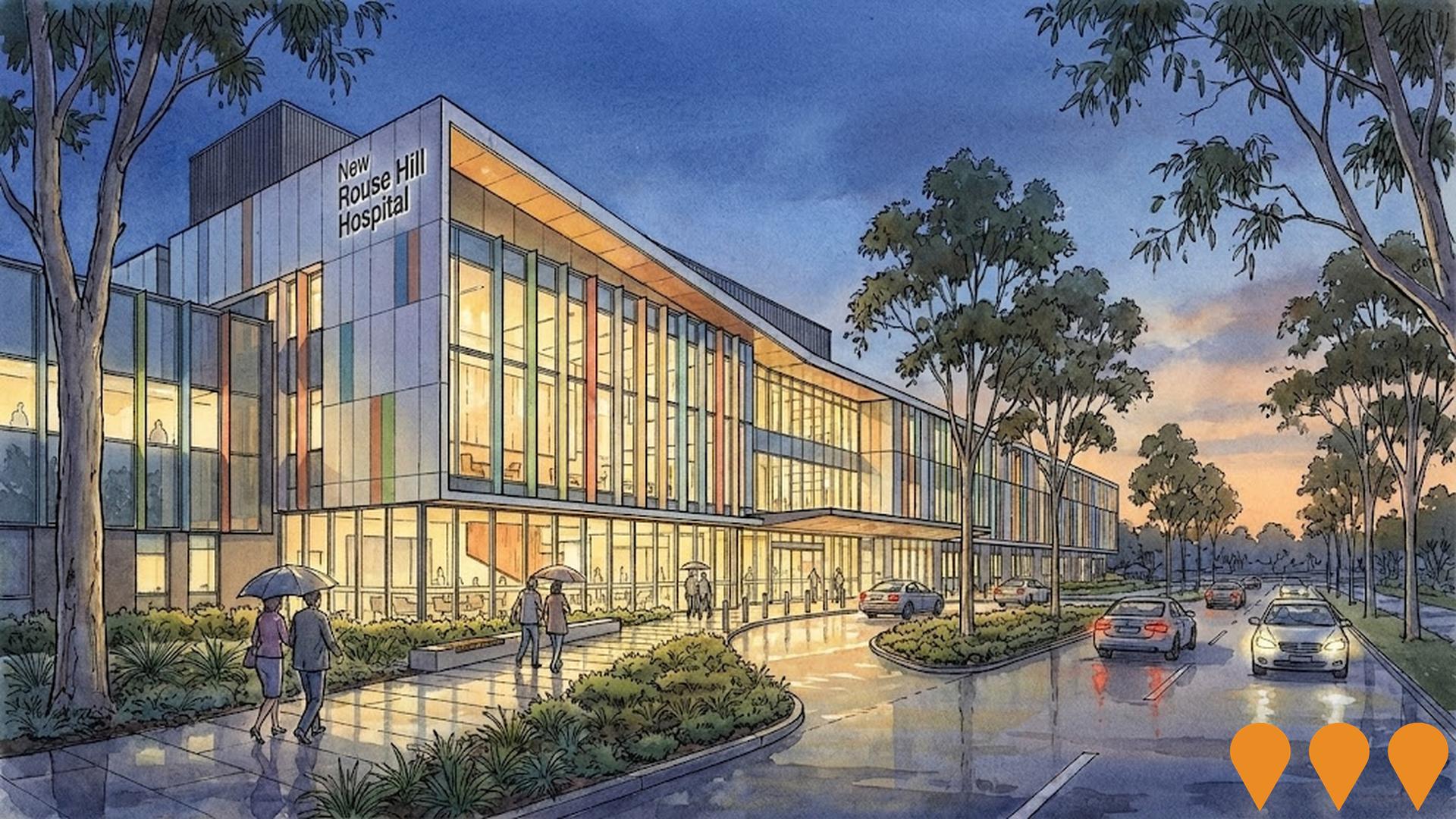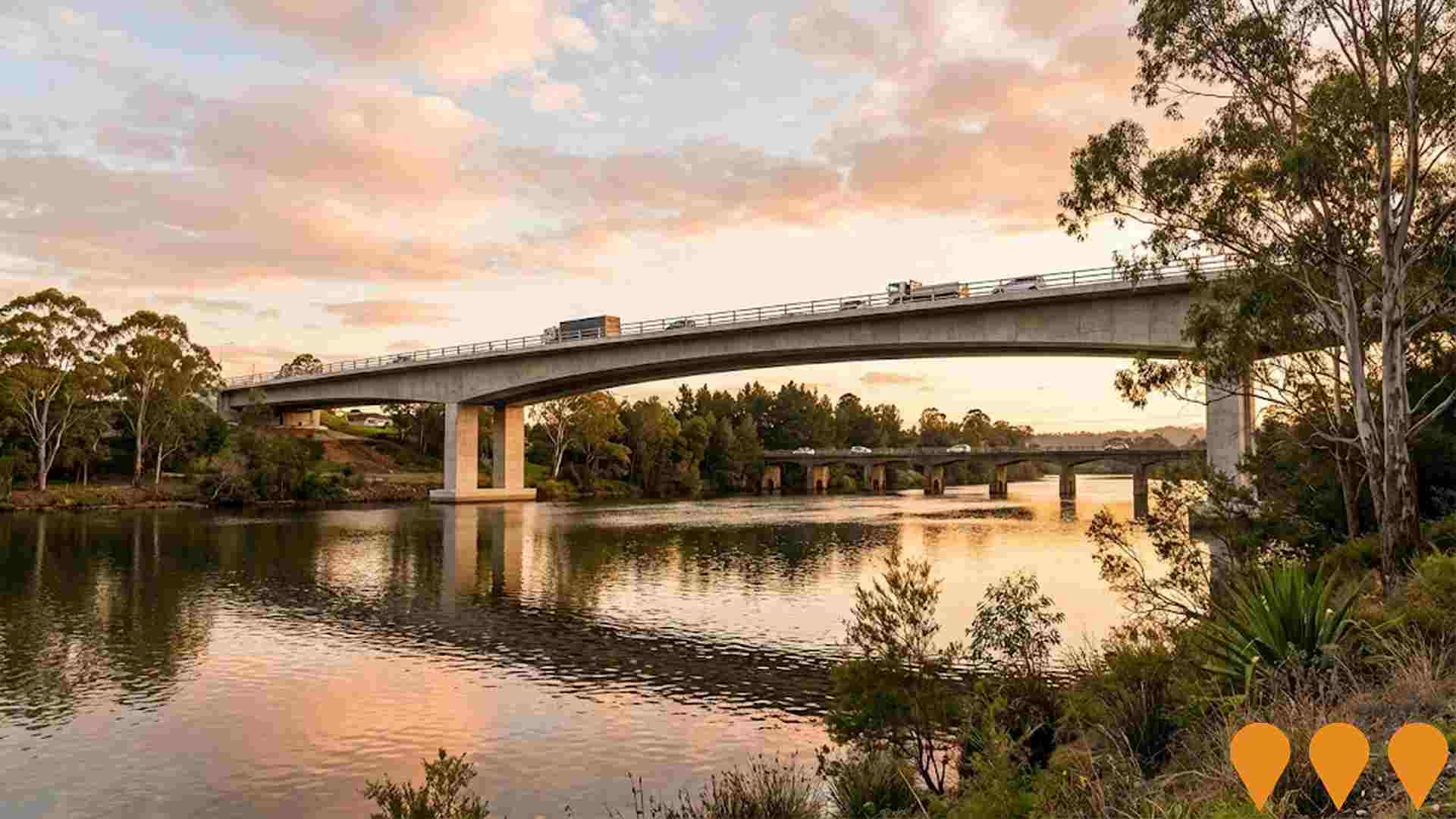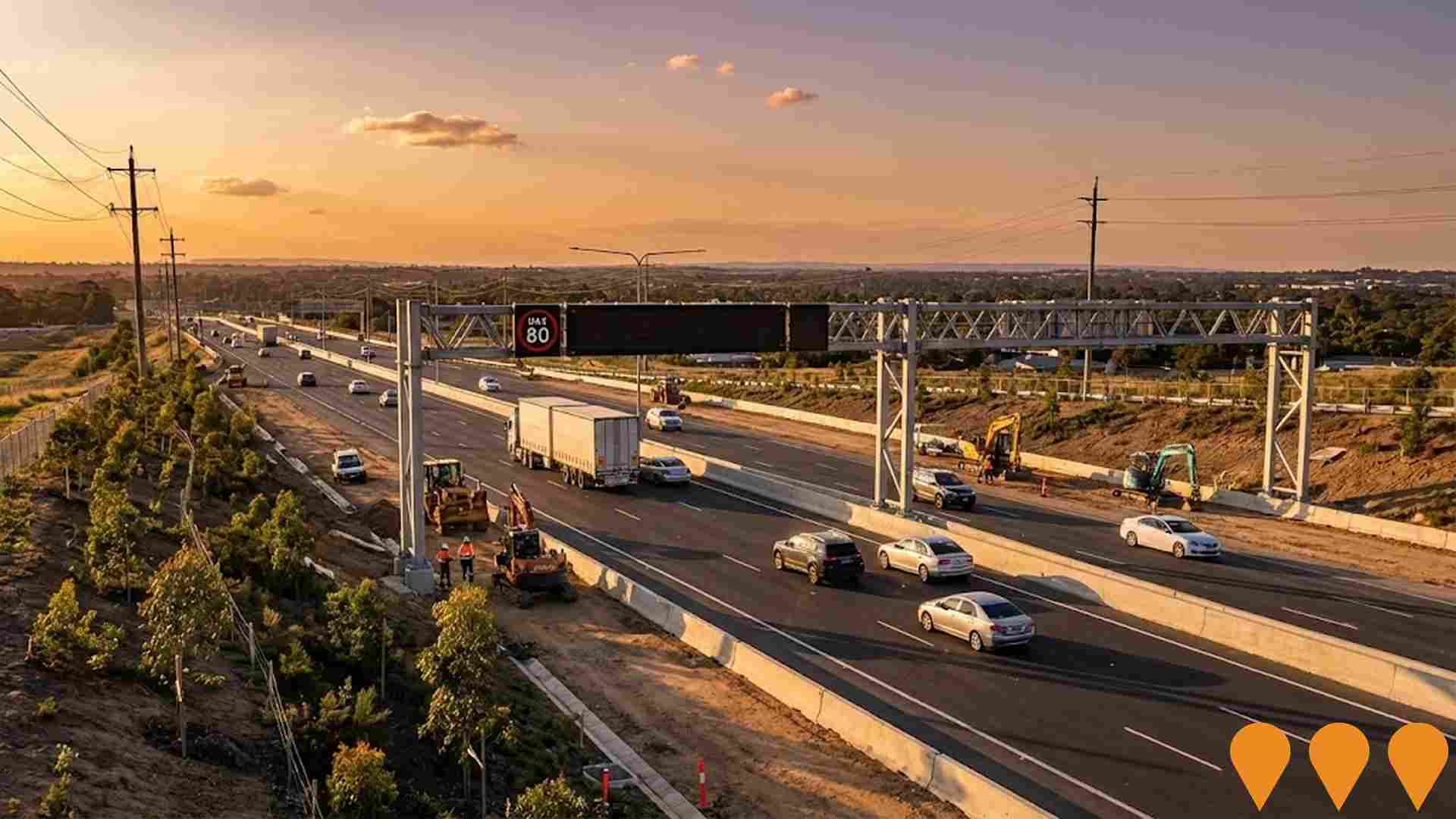Chart Color Schemes
est. as @ -- *
ABS ERP | -- people | --
2021 Census | -- people
Sales Activity
Curious about local property values? Filter the chart to assess the volume and appreciation (including resales) trends and regional comparisons, or scroll to the map below view this information at an individual property level.
Find a Recent Sale
Sales Detail
Population
An assessment of population growth drivers in Bilpin - Colo - St Albans reveals an overall ranking slightly below national averages considering recent, and medium term trends
Based on AreaSearch's analysis, Bilpin-Colo-St Albans' population is around 2821 as of August 2025. This reflects a decrease of 25 people (0.9%) since the 2021 Census, which reported a population of 2846 people. The change is inferred from the estimated resident population of 2809 from the ABS as of June 2024 and an additional 9 validated new addresses since the Census date. This level of population equates to a density ratio of 1.3 persons per square kilometer. Over the past decade, Bilpin-Colo-St Albans has demonstrated resilient growth patterns with a compound annual growth rate of 0.2%, outpacing the SA3 area. Population growth for the area was primarily driven by overseas migration, contributing approximately 72.7% of overall population gains during recent periods.
AreaSearch is adopting ABS/Geoscience Australia projections for each SA2 area, as released in 2024 with 2022 as the base year. For any SA2 areas not covered by this data, AreaSearch is utilising the NSW State Government's SA2 level projections, as released in 2022 with 2021 as the base year. Growth rates by age group from these aggregations are also applied to all areas for years 2032 to 2041. Considering the projected demographic shifts, over this period, projections indicate a decline in overall population, with the area's population expected to decline by 267 persons by 2041 according to this methodology. However, growth across specific age cohorts is anticipated, led by the 85 and over age group, which is projected to expand by 131 people.
Frequently Asked Questions - Population
Development
The level of residential development activity in Bilpin - Colo - St Albans is very low in comparison to the average area assessed nationally by AreaSearch
Bilpin-Colo-St Albans has seen approximately five dwellings receive development approval annually over the past five financial years, totalling 25 homes. As of FY-2026, zero approvals have been recorded yet. The population decline in recent years has kept housing supply adequate relative to demand, resulting in a balanced market with good buyer choice. New homes are being built at an average construction cost value of $536,000.
This financial year, $6.2 million in commercial approvals have been registered, indicating the area's primarily residential nature. Compared to Greater Sydney, Bilpin-Colo-St Albans has 14.0% less new development per person and ranks among the 30th percentile nationally, offering limited buyer choices and supporting demand for existing dwellings. This is below average nationally, suggesting maturity and possible planning constraints. All new construction consists of detached dwellings, maintaining the area's traditional low-density character focused on family homes.
With an estimated 670 people per dwelling approval, it reflects a quiet, low-activity development environment. Given stable or declining population forecasts, Bilpin-Colo-St Albans may experience less housing pressure, creating favourable conditions for buyers.
Frequently Asked Questions - Development
Infrastructure
Bilpin - Colo - St Albans has very high levels of nearby infrastructure activity, ranking in the top 20% nationally
Changes in local infrastructure significantly impact an area's performance. AreaSearch identified 13 projects that could affect this region. Notable projects include Jacaranda Ponds, Hawkesbury-Neap Valley Flood Management, Road Improvement Program - Wire Lane, Freemans Reach, and Freemans Reach Reserve - Playground Upgrade. The following list details those most relevant.
Professional plan users can use the search below to filter and access additional projects.
INFRASTRUCTURE SEARCH
 Denotes AI-based impression for illustrative purposes only, not to be taken as definitive under any circumstances. Please follow links and conduct other investigations from the project's source for actual imagery. Developers and project owners wishing us to use original imagery please Contact Us and we will do so.
Denotes AI-based impression for illustrative purposes only, not to be taken as definitive under any circumstances. Please follow links and conduct other investigations from the project's source for actual imagery. Developers and project owners wishing us to use original imagery please Contact Us and we will do so.
Frequently Asked Questions - Infrastructure
Low and Mid-Rise Housing Policy
State-wide NSW planning reforms via amendments to the State Environmental Planning Policy to enable more diverse low and mid-rise housing (dual occupancies, terraces, townhouses, manor houses and residential flat buildings up to 6 storeys) in well-located areas within 800 m of selected train, metro and light-rail stations and town centres. Stage 1 (dual occupancies in R2 zones statewide) commenced 1 July 2024. Stage 2 (mid-rise apartments, terraces and dual occupancies near stations) commenced 28 February 2025. Expected to facilitate up to 112,000 additional homes over the next five years.

Rouse Hill Hospital
New $910 million public hospital serving Sydney's north-west growth corridor. 300+ beds, emergency department, maternity, ICU, operating theatres, paediatrics, renal dialysis, medical imaging and integrated digital health. First major adult public hospital built in Western Sydney in over 40 years. SSDA for main works lodged and on public exhibition until 10 December 2025. Early works contractor appointment imminent. Main construction expected to start late 2025/early 2026, with staged opening from 2028.

Redbank North Richmond Master-Planned Community
Redbank North Richmond is a 180 hectare master planned community in the Hawkesbury that will deliver about 1,399 detached homes plus an 80 bed aged care facility and a 192 home retirement village, alongside extensive parklands and open space. The $1.8 billion project includes a village centre with a cafe and restaurant, vet hospital and supermarket, with stage 2 of the Redbank Village centre and an IGA supermarket now under construction. The estate is well advanced, with planning reports noting that more than 900 lots have been sold, around 914 lots registered and about 700 lots already occupied, while new stages such as Cumberland Place and The Promenade continue to be released. Recent council planning proposals focus on minor zoning and control amendments across the existing estate and do not increase dwelling yield, while a separate planning proposal covers a Redbank expansion area at Kemsley Park. The community is supported by new childcare and community facilities, and future regional connectivity is to be improved through the proposed Grose River Bridge project being delivered in partnership with Transport for NSW and Hawkesbury City Council. :contentReference[oaicite:0]{index=0} :contentReference[oaicite:1]{index=1} :contentReference[oaicite:2]{index=2}

New Richmond Bridge and Traffic Improvements
Traffic and flood-resilience upgrade led by Transport for NSW delivering a new higher four-lane bridge over the Hawkesbury River downstream of the existing Richmond Bridge, a bypass of Richmond town centre, and upgrades to key intersections on The Driftway. Stage 1 (The Driftway intersections and enabling works) has a major construction contract awarded and is commencing in 2025, with completion targeted for 2027. Stage 2 will deliver the new bridge and associated works, with design and procurement progressing following community consultation.

Newcastle-Sydney and Wollongong-Sydney Rail Line Upgrades
Program of upgrades to existing intercity rail corridors linking Newcastle-Central Coast-Sydney and Wollongong-Sydney to reduce travel times and improve reliability. Current scope includes timetable and service changes under the Rail Service Improvement Program, targeted network upgrades (signalling, power, station works) and the introduction of the Mariyung intercity fleet on the Central Coast & Newcastle Line, alongside Federal planning led by the High Speed Rail Authority for a dedicated Sydney-Newcastle high speed corridor.

Western Sydney Infrastructure Plan
The Western Sydney Infrastructure Plan (WSIP) is a joint Australian and NSW Government 10-year, $4.4 billion road investment program delivering major upgrades across Western Sydney to support population growth and the opening of Western Sydney International Airport in 2026. Key projects include the M12 Motorway (under construction), M4 Smart Motorway, upgrades to The Northern Road and Bringelly Road (largely completed), Werrington Arterial Road (completed 2017), Glenbrook intersection upgrade (completed 2018), and a $200 million Local Roads Package supporting seven Western Sydney councils.

Freemans Reach Reserve - Playground Upgrade
Hawkesbury City Council replaced the older play equipment at Freemans Reach Reserve with a new local playground suitable for children up to 12 years. The upgrade delivers a climbing tower with slide, swings, obstacle course, roundabout, rocker, seating overlooking the sports courts, improved access to tennis courts, a picnic table, bin enclosure, bubbler, new tree planting, landscaping and a walking path. The playground opened in January 2025.

Hambledon Park
Celestino is in early planning for a large masterplanned community on a ~253 ha site at 393 Terrace Road, North Richmond. As of late 2024/2025 the developer states no formal planning applications have been lodged; they completed early community engagement to inform a forthcoming Scoping Proposal. The vision references a school, health services, retail, sports fields and resilience facilities, but dwelling numbers are not yet determined.

Employment
Employment drivers in Bilpin - Colo - St Albans are experiencing difficulties, placing it among the bottom 20% of areas assessed across Australia
Bilpin-Colo-St Albans has a skilled workforce with notable representation in the construction sector. The unemployment rate was 6.5% as of June 2025, with an estimated employment growth of 1.7% over the past year.
As of this date, 1,509 residents were employed while the unemployment rate was 2.3% higher than Greater Sydney's rate of 4.2%. Workforce participation was lower at 55.7%, compared to Greater Sydney's 60.0%. Key employment industries among residents include construction, health care & social assistance, and education & training. The area shows strong specialization in construction with an employment share 1.8 times the regional level.
Conversely, professional & technical services have lower representation at 5.6% compared to the regional average of 11.5%. Employment opportunities locally appear limited based on Census data comparison of working population against resident population. In the 12-month period ending June 2025, employment increased by 1.7%, while labour force grew by 3.3%, leading to a rise in unemployment rate by 1.5 percentage points. This contrasts with Greater Sydney where employment rose by 2.6%, labour force grew by 2.9%, and unemployment rose by 0.3 percentage points. National employment forecasts from Jobs and Skills Australia, released in May 2025, project national employment growth of 6.6% over five years and 13.7% over ten years. Applying these projections to Bilpin-Colo-St Albans' employment mix suggests local growth of approximately 5.9% over five years and 12.5% over ten years.
Frequently Asked Questions - Employment
Income
Income levels align closely with national averages, indicating typical economic conditions for Australian communities according to AreaSearch analysis
AreaSearch's latest postcode level ATO data for financial year 2022 shows Bilpin - Colo - St Albans had a median income of $52,146 and an average income of $68,032 among taxpayers. This is higher than the national average. Greater Sydney's median income was $56,994 with an average of $80,856 in the same period. Based on Wage Price Index growth of 12.61% since financial year 2022, estimated current incomes for Bilpin - Colo - St Albans would be approximately $58,722 (median) and $76,611 (average) as of September 2025. According to the 2021 Census, household, family, and personal incomes in Bilpin - Colo - St Albans rank modestly between the 38th and 47th percentiles. The earnings profile indicates that 32.0% of residents earn $1,500 - $2,999 weekly (902 residents), similar to the metropolitan region where this cohort represents 30.9%. Housing affordability pressures are severe with only 84.1% of income remaining, ranking at the 47th percentile. The area's SEIFA income ranking places it in the 6th decile.
Frequently Asked Questions - Income
Housing
Bilpin - Colo - St Albans is characterized by a predominantly suburban housing profile, with above-average rates of outright home ownership
In Bilpin-Colo-St Albans, as per the latest Census evaluation, 98.8% of dwellings were houses, with 1.2% being other types such as semi-detached homes, apartments, and 'other' dwellings. This is similar to Sydney metro's breakdown of 98.7% houses and 1.2% other dwellings. Home ownership in Bilpin-Colo-St Albans stood at 43.3%, with mortgaged properties at 47.9% and rented ones at 8.8%. The median monthly mortgage repayment was $2,167, lower than Sydney metro's average of $2,308. The median weekly rent in the area was $320, compared to Sydney metro's $430. Nationally, Bilpin-Colo-St Albans' mortgage repayments were higher at $2,167 versus Australia's average of $1,863, while rents were lower at $320 compared to the national figure of $375.
Frequently Asked Questions - Housing
Household Composition
Bilpin - Colo - St Albans has a typical household mix, with a lower-than-average median household size
Family households comprise 71.9% of all households, including 31.0% couples with children, 33.9% couples without children, and 6.8% single parent families. Non-family households account for the remaining 28.1%, with lone person households at 24.9% and group households comprising 2.3%. The median household size is 2.5 people, which is smaller than the Greater Sydney average of 2.9.
Frequently Asked Questions - Households
Local Schools & Education
Educational attainment in Bilpin - Colo - St Albans aligns closely with national averages, showing typical qualification patterns and performance metrics
The area's university qualification rate is 23.1%, significantly lower than the SA4 region average of 40.4%. Bachelor degrees are most common at 14.4%, followed by postgraduate qualifications (6.1%) and graduate diplomas (2.6%). Vocational credentials are prevalent, with 45.4% of residents aged 15+ holding them, including advanced diplomas (12.7%) and certificates (32.7%). Educational participation is high at 27.6%, comprising primary education (10.7%), secondary education (8.5%), and tertiary education (2.7%).
The three schools in Bilpin - Colo - St Albans have a combined enrollment of 71 students, with typical Australian school conditions (ICSEA: 1004) offering balanced educational opportunities. These schools focus on primary education only, with secondary options available nearby. Local school capacity is limited at 2.5 places per 100 residents compared to the regional average of 9.7, resulting in many families traveling for schooling.
Frequently Asked Questions - Education
Schools Detail
Nearby Services & Amenities
Transport
Transport servicing is low compared to other areas nationally based on assessment of service frequency, route connectivity and accessibility
Public transport analysis shows 122 active transport stops operating within Bilpin-Colo-St Albans area. These are served by a mix of bus routes, totaling 16 individual routes. Together, these routes provide 160 weekly passenger trips.
Transport accessibility is rated as limited, with residents typically located 895 meters from the nearest stop. Service frequency averages 22 trips per day across all routes, equating to approximately one weekly trip per stop.
Frequently Asked Questions - Transport
Transport Stops Detail
Health
Bilpin - Colo - St Albans's residents are healthier than average in comparison to broader Australia with a fairly standard level of common health conditions seen across both young and old age cohorts
Health data shows positive outcomes for Bilpin-Colo-St Albans residents with standard levels of common health conditions across young and old age cohorts.
Approximately 53% (~1,506 people) have private health cover. The most prevalent medical conditions are arthritis (8.4%) and asthma (6.9%). Around 69.4% report being free from medical ailments, compared to 70.4% in Greater Sydney. The area has 24.0% of residents aged 65 and over (678 people), higher than Greater Sydney's 18.9%. Health outcomes among seniors are notably strong, outperforming the general population in health metrics.
Frequently Asked Questions - Health
Cultural Diversity
Bilpin - Colo - St Albans ranks below the Australian average when compared to other local markets across a number of language and cultural background related metrics
Bilpin-Colo-St Albans, as per the census conducted on Tuesday 9 August 2016, exhibited lower cultural diversity compared to the national average. The population was predominantly Australian-born citizens: 86.7% were citizens, and 84.4% had been born in Australia. English was spoken at home by 95.0% of the residents.
Christianity was the dominant religion, practiced by 52.5% of the population. Notably, Judaism, which constituted only 0.1% of Greater Sydney's population, comprised 0.4% of Bilpin-Colo-St Albans' inhabitants, indicating an overrepresentation. In terms of ancestry, Australians made up the largest group at 29.9%, followed by those of English descent at 29.5%, and Irish at 9.3%. However, there were significant deviations in the representation of certain ethnic groups: Dutch residents accounted for 1.9% compared to the regional average of 1.5%, Maltese residents made up 1.4% versus a regional average of 4.8%, and South Africans constituted 0.6% against a regional average of 0.3%.
Frequently Asked Questions - Diversity
Age
Bilpin - Colo - St Albans hosts an older demographic, ranking in the top quartile nationwide
Bilpin-Colo-St Albans's median age is 48 years, significantly higher than Greater Sydney's average of 37 years and Australia's national median of 38 years. The age profile shows that those aged 55-64 are particularly prominent, making up 18.4% of the population, compared to the national average of 11.2%. Meanwhile, the 25-34 age group is smaller at 8.1%, compared to Greater Sydney's figure. Between 2021 and present, the 75-84 age group has grown from 7.1% to 9.4%, while the 15-24 cohort increased from 9.8% to 11.1%. Conversely, the 5-14 age group declined from 10.9% to 9.5%, and the 45-54 age group dropped from 16.5% to 15.1%. Population forecasts for 2041 indicate substantial demographic changes in Bilpin-Colo-St Albans, with the 85+ cohort projected to grow by 209%, adding 123 residents to reach 182. Senior residents aged 65 and above will drive all population growth, reflecting ongoing demographic aging trends. Conversely, population declines are projected for those aged 0-4 and 25-34 years.

